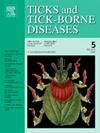Exploring Borrelia in Australia: Isolation, genomic characterisation, and host and vector associations
IF 3.4
2区 医学
Q2 INFECTIOUS DISEASES
引用次数: 0
Abstract
Borrelia are tick-borne spirochetes that include important pathogens that cause Lyme borreliosis and relapsing fevers. While multiple Borrelia species have been identified in Australia, further research is needed to understand their ecological roles and potential zoonotic risks. This study aimed to isolate and characterise two Australian Borrelia species—Borrelia tachyglossi and Borrelia sp. HB—through in vitro culture, genomic sequencing, and molecular surveys of ticks and vertebrate hosts. Despite extensive efforts, Borrelia sp. HB could not be cultured from Haemaphysalis bancrofti ticks, and its prevalence in questing ticks was low (0.14 %). Additionally, molecular screening of 504 wildlife hosts found no evidence of Borrelia sp. HB infection, suggesting a cryptic or highly restricted enzootic cycle. In contrast, B. tachyglossi was successfully cultured from Bothriocroton concolor ticks collected from echidnas (Tachyglossus aculeatus), enabling complete genome sequencing. Complement-mediated bactericidal assays demonstrated that B. tachyglossi is highly susceptible to human innate immunity, indicating it is unlikely to be pathogenic. Molecular surveys of wildlife-associated ticks revealed a broad diversity of reptile-associated Borrelia species in monitor lizards and snakes, reinforcing the hypothesis that Australian Borrelia persist in host-specific enzootic cycles. Our findings confirm that Borrelia species in Australia belong exclusively to the relapsing fever and reptile-associated clades, with no evidence of B. burgdorferi sensu lato. These results improve our understanding of Borrelia diversity in Australia and highlight the need for further research into their ecology, vector competence, and evolutionary history.
探索澳大利亚伯氏疏螺旋体:分离,基因组特征,宿主和媒介关联
疏螺旋体是蜱传播的螺旋体,包括导致莱姆病和回归热的重要病原体。虽然在澳大利亚已经发现了多种疏螺旋体,但需要进一步研究以了解它们的生态作用和潜在的人畜共患风险。本研究旨在通过体外培养、基因组测序和蜱虫和脊椎动物宿主的分子调查,分离和表征两种澳大利亚伯氏疏螺旋体——快舌伯氏疏螺旋体和伯氏疏螺旋体。尽管进行了广泛的努力,但无法从班氏血蜱中培养出伯氏疏螺旋体HB,其在探索蜱中的流行率很低(0.14%)。此外,504个野生动物宿主的分子筛选未发现伯氏疏螺旋体HB感染的证据,表明存在隐性或高度限制性的地方性动物循环。相比之下,从针鼹(Tachyglossus aculeatus)收集的Bothriocroton concolor蜱中成功培养出了B. tachyglossi,并进行了全基因组测序。补体介导的杀菌试验表明,速舌芽胞杆菌对人类先天免疫高度敏感,表明它不太可能具有致病性。对野生动物相关蜱虫的分子调查显示,与爬行动物相关的伯氏疏螺旋体在监测蜥蜴和蛇中具有广泛的多样性,这加强了澳大利亚伯氏疏螺旋体在宿主特异性地方性动物循环中持续存在的假设。我们的研究结果证实,澳大利亚的伯氏疏螺旋体物种完全属于回归热和爬行动物相关的分支,没有证据表明伯氏疏螺旋体的存在。这些结果提高了我们对澳大利亚伯氏疏螺旋体多样性的认识,并强调了对其生态学、媒介能力和进化史进行进一步研究的必要性。
本文章由计算机程序翻译,如有差异,请以英文原文为准。
求助全文
约1分钟内获得全文
求助全文
来源期刊

Ticks and Tick-borne Diseases
INFECTIOUS DISEASES-MICROBIOLOGY
CiteScore
6.90
自引率
12.50%
发文量
185
审稿时长
6-12 weeks
期刊介绍:
Ticks and Tick-borne Diseases is an international, peer-reviewed scientific journal. It publishes original research papers, short communications, state-of-the-art mini-reviews, letters to the editor, clinical-case studies, announcements of pertinent international meetings, and editorials.
The journal covers a broad spectrum and brings together various disciplines, for example, zoology, microbiology, molecular biology, genetics, mathematical modelling, veterinary and human medicine. Multidisciplinary approaches and the use of conventional and novel methods/methodologies (in the field and in the laboratory) are crucial for deeper understanding of the natural processes and human behaviour/activities that result in human or animal diseases and in economic effects of ticks and tick-borne pathogens. Such understanding is essential for management of tick populations and tick-borne diseases in an effective and environmentally acceptable manner.
 求助内容:
求助内容: 应助结果提醒方式:
应助结果提醒方式:


